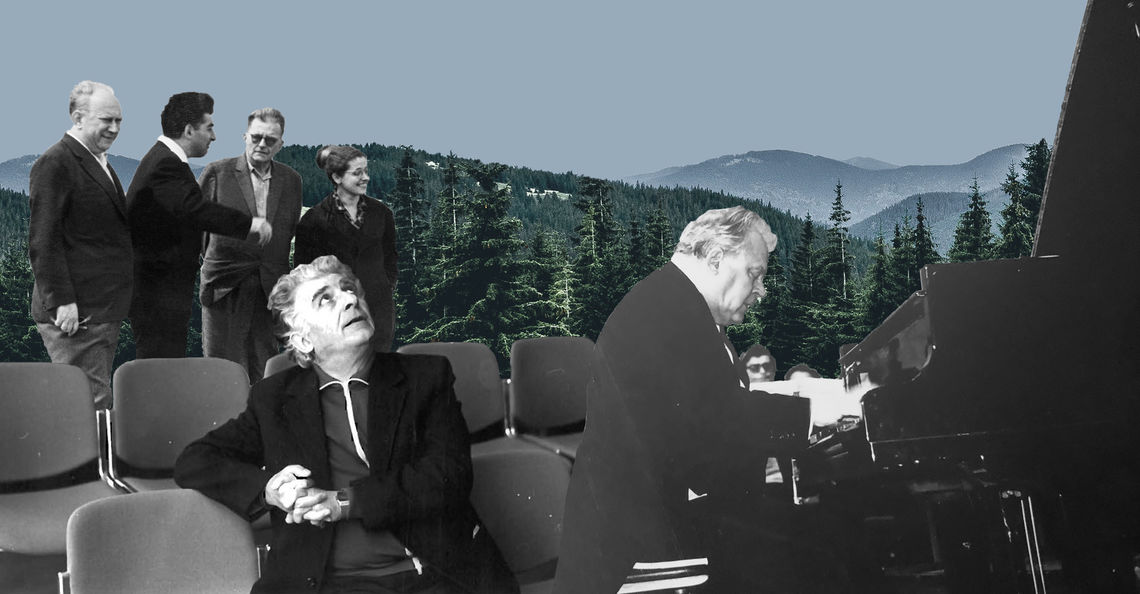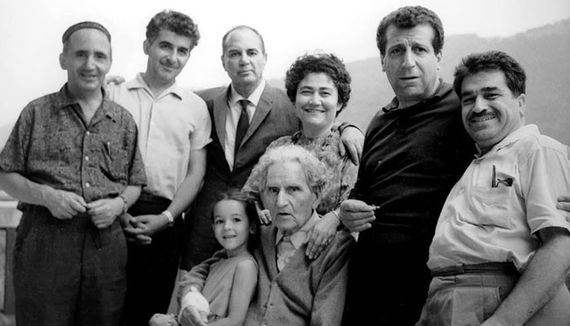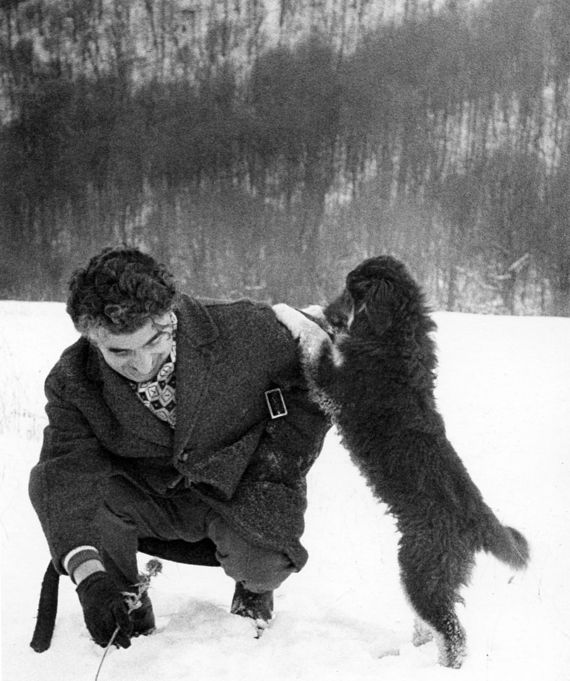
Driving into Dilijan, after passing through the legendary roundabouts, road signs start pointing to various resorts and hotels. One particular sign immediately stands out: a big blue board, with the inscription “Edward Mirzoyan Composers’ Union Resort.” It leads to one of the most famous cultural hubs of the former Soviet Union.
In the early 1960s, there was a plan to build a composers’ resort in one of the Transcaucasian Soviet republics. Both Azerbaijan and Georgia wanted to implement the project in their territory. While those nations were negotiating with state officials, composer Edward Mirzoyan, head of the Composers’ Union of Armenia at the time, managed to quickly get all the necessary approvals and immediately started the implementation of the project in Soviet Armenia. However, it was not an easy task.
When Anton Kochinyan, then the First Secretary of the Communist Party of Armenia, gave the state’s approval to build the resort, Mirzoyan’s next task was to find a location for it. “I looked at 12 locations across Armenia, four of them on Kochinyan’s advice,” Mirzoyan wrote in his memoirs. “I looked at Lori, Aghveran, Parz Lake (Kochinyan promised that the roads would be fixed), but I did not agree to build in any of those places… I tried the rose hips in Aghveran; they were sweet, meaning that the winters were cold. And every time we tried driving to Parz Lake, the car would skid.”
It appeared, however, that Parz Lake was the preferred location for the authorities. In fact, several high ranking officials from Moscow, who were responsible for the project, even came to Armenia to inspect the area. Although they were not able to reach the lake because of the horrible condition of the roads, they nonetheless determined that it was a suitable location and that construction should begin. Edward Mirzoyan was not happy with that decision because he had been told that the mosquitoes were intolerable around the lake. He was persistent – he would not allow the project to be implemented in an area that was not suitable for its intended purpose of creative work and recreation. He opposed the initial decision and told Kochinyan that he refused to build the resort near Parz Lake.
“I see that there is no escape from you,” Kochinyan told Mirzoyan. “We have kept one place for us [government representatives] in Golovino [an area near Dilijan]. You can have it, along with the garden. You can start the construction.”
In 1961, thanks to Mirzoyan’s persistence, construction began on the Composers’ Union Dilijan Resort. His widow, Yelena Mirzoyan, recalls that he was so involved in the construction process in Dilijan that he even oversaw where to hang the chandeliers in the cottages. “One day, he came home from work and told me that he’s immediately driving to Dilijan. When I asked why, he said that he needed to tell the construction workers exactly where to put the power sockets,” recalls Yelena Mirzoyan.
In 1963, the Composers’ Union Dilijan Resort opened its doors with eight cottages designed specifically for composers. Each cottage had a grand piano and was built the right distance from each other so as not to disturb the neighbors when playing music. Throughout the years, more cottages and other functional buildings were added. The site also had apple trees and a small greenhouse.
Upon opening, it did not take long for the Resort to become one of the most desired destinations for Soviet musicians. “It was a peaceful corner, perfect for creative work amid forests with amazing fresh air,” says composer Yervand Yerkanyan, who was part of Dilijan’s social and cultural circles in the 1970s.

Dilijan, 1966. From left – Writer Khachik Dashtents, Edward Mirzoyan, American-Armenian writer Levon Zaven Syurmelyan, writer and poet Silva Kaputikyan, composer Arno Babajanyan, photographer Andranik Qochar. Sitting – painter Martiros Saryan with his granddaughter.

Dilijan, 1960s. From left – Edward Mirzoyan, painter Martiros Saryan, composer Aram Khachaturian, and Edward Mirzoyan’s secretary Babken Sosyan.
“It immediately became a beloved place because it had all-union significance. Right after it opened, it began to host musical weeks and cultural days of various countries such as Bulgaria, Poland, Czechoslovakia and Germany,” Yerkanyan recalls. “It also hosted the forum of Soviet and Italian composers. Moreover, because the complex was a beautiful and comfortable place, many important events were organized there instead of Moscow.”
Another unique aspect of the Composers’ Union Dilijan Resort was that it quickly became a cultural hub for many world-famous guests. Here, hidden in a small mountainous corner of Armenia, you could play football with famous Russian composer Dmitri Shostakovich or Armenian composer Arno Babajanyan; you could meet the renowned painter Martiros Saryan or collect mushrooms with one of the most famous ballerinas of her time, Maya Plisetskaya.
Musicians, composers, writers and artists from all over the world, including Aram Khachaturyan, Benjamin Britten, Krzysztof Meyer, Giya Kancheli, Philip Glonti, Mstislav Rostropovich, Galina Vishnevskaya, Rodion Shchedrin, Anna Zegers, and Hans Buchholz visited and worked at the resort. The complex provided all the necessary conditions for accommodating the productive process of creative work.
Soviet composer Dmitri Shostakovich spent four holidays in Dilijan. During his visits, he composed his famous String Quartet No. 9, as well as music for the Soviet film “Hamlet.”
“I remember Shostakovich would always stay in Cottage #8,” recalls Yelena Mirzoyan. “There was a football field in front of it. One day, we had a football game. Arno Babajanyan was leading one group. Composer Rodion Schedrin, with his wife Maya Plistskaya, was leading the other. Shostakovich was the referee. And every time someone would hit the trees and apples would fall, he would get angry and assign a penalty.”
In 1965, world-famous British composer Benjamin Britten and his friend, singer Peter Pears came to Dilijan. Soviet Armenia was hosting the “Days of Benjamin Britten” and Dilijan was the composer’s main destination. During his stay, he composed a song cycle for high voice and piano and dedicated it to his friends, soprano Galina Vishnevskaya and cellist and pianist Mstislav Rostropovich, who were also vacationing in Dilijan. Yelena Mirzoyan notes that Peter Pears later wrote in his memoirs that British composers would dream to have such a resort.
In the 1970s, people around the world came to Dilijan not only to rest and create but also to meet their colleagues and experience the cultural atmosphere of the times. “There is a recording where Georgian composer Felix Glonti confesses that, even though they already have a resort for Georgian composers in Borjomi, he preferred to come to Dilijan just to meet with composers Edward Mirzoyan, Arno Babajanyan, and Ghazaros Saryan. For him, Dilijan had a completely different atmosphere. Composers would come, exchange ideas, show each other their work,” recalls Yelena Mirzoyan.
Another famous guest of the resort was the founder of the modern Armenian school of painting, Martiros Saryan. Yelena Mirzoyan recounted a story about Saryan: “Every morning he used to stand on his balcony and say ‘This is amazing!’ Once, the cleaner came and told us that Saryan had lost his mind and kept repeating the same phrase every day. But of course that was not the case; he was so fascinated by nature that he kept repeating the same phrase every single day.”
The years in Dilijan were special not only for composers but also for their families and children. With a smile on his face, Professor Arshak Mirzoyan, a medical doctor and Edward Mirzoyan’s son, recalls his childhood memories in Dilijan. “I spent my whole childhood there, and they were happy days. For us, it was normal to meet Maya Plisetskaya on our way to the cafeteria. And I remember how Arno Babajanyan would gather all the children and tell stories. Now I understand how privileged I was.”
The Beethoven Concert Hall
In the 1970s, the Composers’ Union Dilijan Resort continued to expand. With 25 cottages, an open-air pool, a restaurant, a conference hall, a sports center, and breathtaking nature, what else would one need for the perfect vacation and inspiring creative work?

Dilijan, 1981. Edward Mirzoyan during the construction of Beethoven Hall.

Edward Mirzoyan with his dog in Dilijan.
Edward Mirzoyan, who never stopped working to improve the complex, soon realized that it needed a concert hall – a special place to showcase the fruits of the creative minds that it housed. However, that would be another challenge. In the 1980s, Soviet authorities were not keen to build concert halls; such projects were not being financed. But Mirozyan knew just how to implement this seemingly ambitious project.
It was at the Bolshoi Theatre in Moscow in the 1980s. Soviet officials were celebrating the 200th anniversary of the German composer Ludwig van Beethoven. Representatives of Soviet countries came to the stage to give speeches. When it was Mirzoyan’s turn, he came to the stage and talked about the role of Beethoven in Armenia’s culture. At the very end, he announced, “We are almost finished the construction of the Beethoven Concert Hall at the Composers’ Dilijan Retreat Center.”
At the time of his announcement, the construction had not even begun. But the world had already heard about the concert hall named after Beethoven, putting Soviet authorities in a difficult position. The financing approval followed quickly and it brought new challenges.
“The concert hall has a very interesting story behind it. I remember once we went there with my father to see how the construction was going. The workers had built one of the walls very poorly. I had never seen my father so angry. He asked them, ‘Are you building a barn or a place of culture?’ They had to demolish the wall and build it again,” recalls Arshak Mirzoyan.
The other challenge for the concert hall was its acoustics. Edward Mirzoyan had an idea to substitute huge glass windows for one of the hall’s exterior walls. “My father imagined the juxtaposition of Beethoven’s Moonlight Sonata and the view of the moon from the huge windows. But the acoustics specialists were not happy with the idea of a glass window or the shape of the hall in general. One of them said that good acoustics required a wall to be demolished. Another said the ceiling had to be higher,” Arshak Mirzoyan says. “My father was very sad. Several days later, he took the acoustics specialists to Geghard Monastery on their way to the airport. Luckily, several people were singing in the monastery, and they were all amazed by the superb acoustics. And right there, standing in Geghard, they decided to build the ceiling of the concert hall according to the ceiling model of Armenian monasteries.”
In 1984, Edward Mirzoyan’s seemingly impossible idea was finally realized. The acoustics of the Beethoven Concert Hall became one of the best in Armenia. It’s large glass windows opened to a view of the lush forest. The concert hall, with 600 seats, officially opened its doors on January 28, 1984, with a special concert. Yelena Mirzoyan recalls how amazed Tikhon Khrennikov, the Russian pianist and head of the Soviet Composers’ Union who performed during the opening concert, was by the acoustics. He noted that it compared to the Great Hall of the Moscow Conservatory. The conductor of the opening concert was Valery Gergiev.
Until the 1990s, the Composers’ Union Dilijan Resort continued to be an active hub for musicians. However, after the collapse of the Soviet Union, the newly-independent Republic of Armenia, engulfed in war, crippled by economic difficulties and still recovering from a devastating earthquake, was not able to allocate the resources required for its maintenance.
In 1991, Edward Mirzoyan resigned from his position as the head of the Composers’ Union of Armenia and ceased his activities connected with the Dilijan resort. For the past 30 years, the resort has continued to host guests, but its heydey of the 1960s and 1970s is long gone. Today, it is in need of investments and proper care to once again become a meaningful cultural hub for local and international musicians.

Dilijan, 1980s. In the foreground, from the left -Edward Mirzoyan, the First Secretary of the Armenian Soviet Socialist Republic Karen Demirchyan, and Chairman of the Council of Ministers of the Armenian SSR Fadey Sargsyan during the construction of the Beethoven Hall.

Dilijan, 1965. From the left – composer Arno Babajanyan, cellist Mstislav Rostropovich, singer Peter Pears, composer Benjamin Britten and Edward Mirzoyan.
In 2013, the Composers’ Resort was named after Edward Mirzoyan, the man who put his heart and soul into the project. Without him, the complex would never become an international center for renowned musicians and artists and a proud example of what Armenia can offer the world.
Lilit Yepremyan, “Edward Mirzoyan Through Letters and Dialogues,” 2011, Tigran Mets publishing house.
Photographs provided by Lilit Yepremyan.
Also read
From Censorship to State Sponsorship: The Fate of Jazz in the Soviet Union and Armenia
Jazz and Armenia have a complicated history. From its early beginnings under Soviet rule to contemporary interpretations of jazz, the genre is part of the fabric of Armenian cultural life.
Read more

